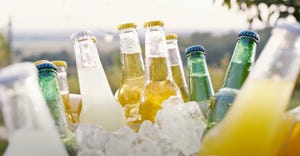Nonalcoholic drinks like soda took a hit during the pandemic, with consumers emerging strongly focused on functional beverages and healthy living.

The beverages industry, as with most areas of consumer goods, retail and wider society, has experienced the most tumultuous year anyone can remember.
According to Euromonitor International, total volume growth across all channels tracked was down 3% globally in 2020. While this may not sound like a lot, the figure is significant in an industry where some degree of volume growth continued even during the recession spanning December 2007 to June 2009.
On-premise, generally away-from-home soft drinks volume in restaurants, bars or elsewhere in foodservice bore the brunt of this disruption. On-trade volume was down a staggering 26% globally. On-trade channels represented about 18% of global soft drinks volume in 2019, excluding fountain sales. In some European markets, such as Spain, these channels can represent up to half of total volume and a much higher percentage of revenue. This high-margin business simply disappeared for a large portion of 2020 in those markets most affected by the COVID-19 pandemic and consequent mobility restrictions.
One key facet of the long-term recovery in global nonalcoholic drinks will be the importance consumers now place on functional drinks and healthy living. If refreshment is the primary source of volume within soft drinks, functionality—defined as beverages that move beyond their basic nutritional value or taste to address a need state or benefit territory—has been the primary source of value creation in the beverages industry over the last two decades.
Functionality begins with energy—particularly caffeine—in energy drinks or the coffee category, which is growing in both packaged and ready-to-drink (RTD) formats. It also extends to sports hydration, where the U.S. and Western Europe have seen consistent growth in sports drinks, athletic nutrition, pre-workout and recovery. But why might functionality, wellness and the priority placed on healthy living matter more moving forward than it did prior to the pandemic? In short, the consumer’s notion of health and wellness is constantly changing—not just in terms of the soft drinks sector, but across food and supplements, as well. The daily routines and health regimens of consumers have been (and continue to be) adjusted and reset.
To continue reading this article, visit “Healthy beverages in 2021” in the “Raise a glass: Innovation in healthy beverages” digital magazine.
Howard Telford is head of soft drinks research at Euromonitor International.
About the Author(s)
You May Also Like






